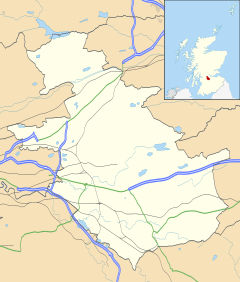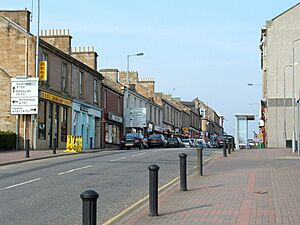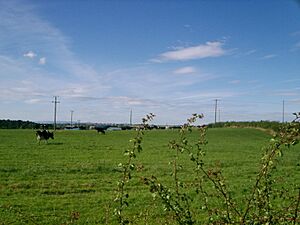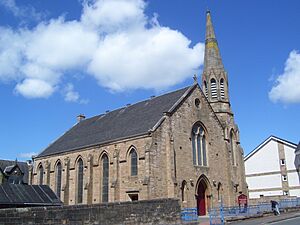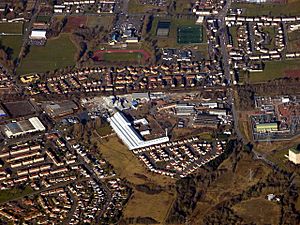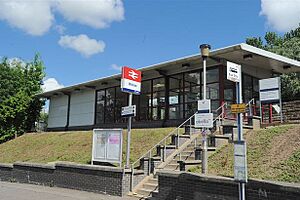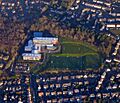Wishaw facts for kids
Quick facts for kids Wishaw
|
|
|---|---|
| Town | |
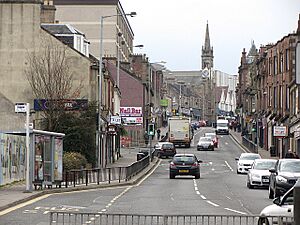 Wishaw Main Street |
|
| Population | 30,050 (2020) |
| OS grid reference | NS795555 |
| • Edinburgh | 31 mi (50 km) |
| Council area | |
| Lieutenancy area | |
| Country | Scotland |
| Sovereign state | United Kingdom |
| Post town | WISHAW |
| Postcode district | ML2 |
| Dialling code | 01698 |
| Police | Strathclyde |
| Fire | Strathclyde |
| Ambulance | Scottish |
| EU Parliament | Scotland |
| UK Parliament |
|
| Scottish Parliament |
|
Wishaw is a big town in North Lanarkshire, Scotland. It sits near the Clyde Valley, about 15 miles south-east of Glasgow city centre.
Wishaw became an official town in 1855. From 1920 to 1975, it was joined with its neighbour, Motherwell, as a larger area. Today, Wishaw is part of the Motherwell and Wishaw voting area. It has the postcode ML2 and the phone code 01698.
Contents
What's in a Name? The Meaning of Wishaw
It's not fully clear how Wishaw got its name. The town is named after Wishaw House, a big house built in the woods near the South Calder Water.
One idea is that "Wishaw" comes from "Via shaw", meaning "way through the woods." This makes sense because an old Roman road went through where the town is now. Another idea is that it means "Wee Shaw," which means "small wood." Or, the "wis" part might come from an old Scottish word for "water," meaning "water wood."
In Scottish Gaelic, the town's main name is Camas Neachdain.
Wishaw Through Time: A Brief History
Ancient Times: Roman Roads and Early Settlements
The area where Wishaw is now was once crossed by important Roman roads. These roads ran through the areas of the Clyde and South Calder Water. In fact, Wishaw's main street today follows the path of a road built by the Romans.
In the 1960s, a pagan statue was found in the woods near Netherton. This shows that people lived near Wishaw even before Christianity arrived in Scotland, which was between 400 and 600 AD.
Medieval Era: Churches, Castles, and Land Owners
Around the 700s, a small church was built by a bend in the Clyde. This area became known as Cambusnethan. The old church site is now a ruined burial ground. It has a round shape, like old Celtic temples in Wales and Ireland. A Christian stone tablet, called the Cambusnethan Stone, was found here.
In the 1100s, a Norman lord built a large house and another small church. This started the parish of Cambusnethan, which lasted until 1930. After the Wars of Scottish Independence, local lords took control of the land. The Somervilles were important families here.
Wishaw House might date back to the 1400s. It appears on an old map from 1583 as Wisha.
Modern Era: Growth and Industry
In the 1700s, farmers in the area mainly grew oats. The village itself was set up in 1794 and was first called Cambusnethan. Later, it was renamed Wishawtown.
By 1801, Wishaw had about 400 people. The town grew a lot in the 1830s. Railways and gasworks came to Wishaw, and many collieries (coal mines) opened. By 1848, Wishaw was a major mining centre. Other industries included making iron and steel, railway wagons, and sweets.
On September 4, 1855, Wishaw officially became a burgh (a type of town) with about 5,000 people. In 1859, St. Ignatius Parish Church was built. In the mid-1800s, the famous Polish composer Frédéric Chopin even visited Wishaw House and played music there!
Wishaw and Motherwell were once big centres for making steel in Scotland. The Ravenscraig steelworks nearby closed in 1992. A local company, R Y Pickering & Co Ltd, built railway wagons and tramcars.
In November 1996, the town experienced a serious health event involving a type of bacteria called E. coli O157.
Recent Decades: Changes and New Jobs
Wishaw has changed since its steelworks and coal mines closed in the 1980s and 1990s. Today, many of the biggest employers in Wishaw are supermarkets. Royal Mail has its main Scottish mail centre here, and University Hospital Wishaw is a big employer for the NHS.
In the 2014 Scottish independence referendum, Wishaw voted 52% in favour of Scottish independence. Since 2015, Wishaw has mostly voted for the Scottish National Party (SNP) in elections.
Town Centre: Shopping and Improvements
Main Street is the main shopping area in Wishaw. It has both big national shops and smaller local stores. There are also many supermarkets, including a Tesco Extra near the railway station. The "Caledonian Centre" is another shopping area with more national chains.
The town centre has seen improvements. In 2004, a new car park and taxi rank were built. An old piece of land near the railway station was turned into a park and ride facility, which helps with parking and traffic.
In 2011, Kitchener Street became a main road to help traffic flow better. A new housing area called Ravenwood was built between 2014 and 2016.
Geography and Weather
Where is Wishaw?
Wishaw is in North Lanarkshire, which is the fourth largest local area in Scotland by population. The town is in the fairly flat Central Belt of Scotland. While there are valleys, there are no very tall hills.
In 2016, Wishaw had a population of 30,290. It used to be considered part of Greater Glasgow, but now Wishaw, Motherwell, and Bellshill are seen as their own separate group of towns.
Wishaw's Climate
Wishaw has mild summers and cool winters. Most rain falls between October and March. Snow is not common in winter, but it does happen about 10–20 days a year. The warmest month is usually July, with an average temperature of 14.7°C. January is the coldest, with an average of 2.3°C.
Wishaw is near two rivers: the Clyde and its smaller river, the South Calder Water.
Public Services and Churches
Education: Schools in Wishaw
Wishaw has three high schools:
- Clyde Valley High School in Overtown
- Coltness High School in Coltness
- St Aidan's High School in Coltness (This school serves Catholic students from Wishaw and nearby towns, so it has about 1,100 pupils).
Primary schools in Wishaw include Calderbridge, St. Thomas', Thornlie, St. Aidan's, Cambusnethan, St. Ignatius', and Wishaw Academy. St. Ignatius' and Wishaw Academy share a campus.
Wishaw does not have its own university or college. The closest college is Motherwell College in Ravenscraig, and the nearest university is the University of the West of Scotland in Hamilton.
Religion: Churches in the Town
Wishaw has many churches for different Christian groups. There are several Church of Scotland churches, including Wishaw Old Parish Church, which has the town clock. Other churches include South Wishaw Parish Church, Cambusnethan North Parish Church, and Coltness Memorial Church.
The town also has a United Free Church, an Episcopal Church, a Baptist church, a Gospel Hall, a Methodist church, and a Christian Outreach Centre.
There are five Roman Catholic Churches:
- St. Ignatius of Loyola
- St. Aidan's
- St. Thomas'
- St. Brigid's
- St. Patrick's
Many Catholics in Wishaw are descendants of Irish Catholics who came to Scotland during the Famine. There are also Catholics from Italian and Polish backgrounds.
Sports and Fun Activities
Sports Facilities
Wishaw does not have a professional football team. Many people in Wishaw support Rangers, Celtic, or nearby Motherwell.
There is a junior football team called Wishaw, which plays at Beltane Park. There's also a big youth football club, Wishaw Wycombe Wanderers, with many young players.
Wishaw has a King George's Field park, named after King George V. It has two football pitches and a play area.
To the northwest of town, there is a large golf course.
The town's sports centre has two swimming pools, areas for badminton and martial arts, and gymnastics equipment. There's also a running track, a football pitch, and 5-a-side football pitches.
The town used to have a much bigger swimming pool, but it closed in the late 1990s. University Hospital Wishaw has a special warm pool for physiotherapy.
Belhaven Park: Wishaw's Town Park
Wishaw has a town park called Belhaven Park, named after Lord Belhaven. It has a play area with climbing frames and slides, and many benches. The play area was updated in 2011.
Getting Around: Transport in Wishaw
Railway Connections
Wishaw railway station is on the Argyle line. This line connects Wishaw to places like:
- Motherwell
- Carluke
- Cambuslang
- Bellshill
- Uddingston
- Glasgow Central
Trains usually run every half hour from Monday to Saturday, and hourly in the late evening and on Sundays.
Wishaw also has a second station, Shieldmuir railway station, which serves the Craigneuk area. There are also some trains to Edinburgh Waverley.
Fast trains on the West Coast Main Line pass through Wishaw, but they don't stop here.
Roads for Travel
Wishaw is on the A71 road, which goes to Edinburgh, Livingston, and Kilmarnock. This road connects Wishaw to the M74 motorway. The A73 also links the town to the Borders region and the M8 motorway.
Road signs for Wishaw have been improved on the M8 and M74 motorways. This is because Wishaw is home to the main hospital for a large area.
Nearest Airports
The closest airport to Wishaw is Glasgow Airport, about 20 miles away. Edinburgh Airport is also not much further, at 26 miles. You can only get to these airports by going through the cities they serve, as there are no direct public transport links from Wishaw.
Wishawhill: A Local Neighbourhood
Wishawhill is a small neighbourhood in the north of Wishaw. You can reach it from Heathery Road or Cleland Road, which connect to the A721 or Glasgow Road leading to Wishaw Main Street.
Wishawhill is close to important places in Wishaw, like Main Street, the big Tesco Extra supermarket, and Wishaw General Hospital. There is also a large golf course nearby. Wishawhill mainly has houses and flats, with a Community Center and the Wishaw Ex-Servicemen's Club as the only non-residential buildings. It has a small local shop, a swing park, and a football pitch.
The Argyle Line railway passes through Wishawhill, and Wishaw railway station is about a mile away. Buses, like those from FirstGroup, travel through the area, connecting it to towns like Motherwell.
Famous People from Wishaw
Many notable people have come from Wishaw, including:
- The Alexander Brothers, musicians and entertainers
- Joe Baker, footballer
- John Cleland, motor racing champion
- Sir Samuel Curran, physicist and inventor
- Alan Fisher, journalist
- Tommy Gemmell, footballer
- John Higgins, world snooker champion
- Paul Higgins, actor and writer
- Lewis Macleod, footballer
- Marie McLaughlin, opera singer
- Lee Miller, footballer
- Nicholas McDonald, singer and runner-up on The X Factor
- Charles Reid (photographer), Victorian Photographer
- Gordon Reid, actor
- Saint Phnx, musical group
- Kieran Tierney, footballer for Arsenal and the Scotland national team
- Thomas Winning, archbishop and cardinal
Images for kids
See also
 In Spanish: Wishaw para niños
In Spanish: Wishaw para niños


